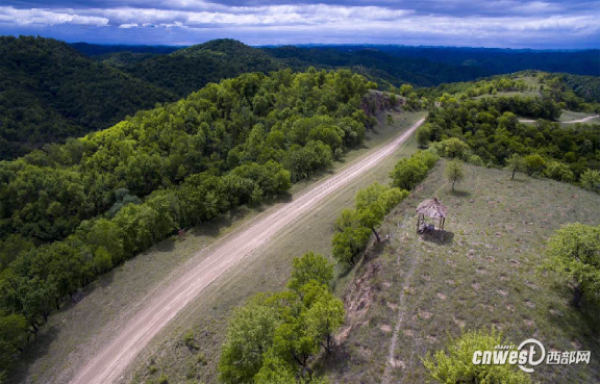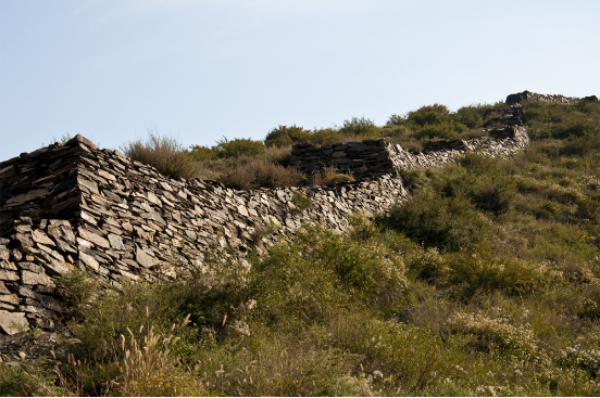Chi Dao and Zhi Dao—the Oldest Express Way
A western saying has that “All roads lead to Rome”, which illustrates western people’s regard toward the 5-meter wide road of the ancient Rome. But 200 years before the prime of the Roman Empire, Emperor Qin Shihuang in China had built the well-known chi dao and zhi dao, the 60-meter-wide express ways that traversed the entire country. zhi dao, in particular, was wide, straight and smooth, which are quite similar to the modern express way. Its artery was so wide that 12 trucks could drive side by side, which won it the laurel of “Oldest Express Way in the World”.

Remains of zhi dao in Shaanxi Province
To intensify the centralized control over the local administrations, in the second year after the unification, Emperor Qin Shihuang ordered the construction of the chi dao network on the basis of the original roads of the six states with the then capital Xianyang as the hinge. This marks the tremendous contribution of the Qin Empire to the transportation culture of ancient China.
chi dao originally referred to the road for the exclusive use of the emperor. But actually, the emperor only used the central ten-meter-wide lane while nobles and officials could use the side lanes when authorized. Therefore, the construction of chi dao was also of great significance for transportation development at that time. After being captured by Zhao Gao, Li Si, one important decision maker of the central government of Qin, felt himself undeserved the imprisonment and presented his seven major political exploits in prison, one of which was the construction of chi dao, which showed the importance of chi dao for the Qin Empire.
Records in the Han Dynasty gave the detailed description of chi dao in the Qin Dynasty. In the records, the road was described to reach 69 meters wide. The remains of road base, east of Tongguan County, Shaanxi, shows that the road is more than 45 meters wide, which provides concrete evidence for historic records. Historic records also depicted that the road was lined with trees for every 10 meters. The road base was rammed firm with metal tools and raised above the ground level, which made the road at that time close to the standards of the modern express way. The adoption of raised road base to ensure sound drainage led the western world by dozens of years. In a famous book on communications and transportation, the former Soviet Union scholar А.К.Бируля proposed that the method of raising the road base to keep the base dry and solid was not adopted in the Europe until the 17th Century. According to him, the first road with such structure was built in Russia in mid 18th century. Moreover, roads of similar structures were not popular until the 19th century in other European countries. This further demonstrates the advanced road-building techniques of the Qin Dynasty.
Zhi dao together with chi dao and the Great Wall were called “the Top Three Massive Projects of the Qin Dynasty”. Zhi dao was a road network initially built for defense purpose against the Huns. In 2,000 years ago, an age with low productivity, the Qin People built in merely two and half years a 50 meter wide road extending 700km with half of the road built on ridges and half on sandy ground or grasslands. Such a massive road construction project was completed in such an extremely short time, which makes it one great wonder in both Chinese road construction history and that of the world. This road started from the capital,
Xianyang, and extended almost straightly northward to Jiuyuan (the recent Baotou area, Inner Mongolia), and was therefore called zhi dao, literally the straight way.
Many remains of zhi dao are still well preserved and in some preserved sections the road surface remains are 22 meters wide with the road base raised above the ground level for about 1 to 1.5 meter. Zhi dao remains in Fangjiahe Village, Ganquan County, showed rammed earth layer and bridge abutments of the ancient bridge approach. On such wide and even road, the military forces of the Qin Empire managed to reach the Hetao Region (in recent Ningxia and Inner Mongolia) from the capital in only three days. Faced with such well-developed transportation of the Qin Empire, the Huns from the north dared not to herd their horses southward or consider any military assault for quite a long time. Zhi dao together with another defense construction, the Great Wall, enabled the infantry of the Qin Army to compete with the valiant Huns on the horse back. All these illustrate the significance of zhi dao in national defense of the Qin Empire.
The Qin Dynasty existed for only dozens of years and zhi dao didn’t fulfill its strategic function until the Han Dynasty when general Wei Qing and Huo Qubing sent by Emperor Wudi of the Han Dynasty scored successful counterattack through the zhi dao of Qin against the Hun’s assaults. After Emperor Wudi came to the throne, he led 180,000 cavalrymen from Ganquan Palace, through zhi dao northward to Shuofang, the ancient name for north China outside the Great Wall. On his way back, people congratulated his success with thundering festive waist-drum performance, which was kept till recently known as the Ansai Waist-drum Show. When Emperor Yuandi of the Han Dynasty decided to marry Wang Zhaojun, a maid of the imperial palace, to the chief of the Huns, Huhanye, the chief, visited the Qin Emperor and went back with Zhaojun through the well-guarded chi dao. In fact, the military significance of chi dao was obvious in the successive generations and it remained an important military artery even in the Tang Dynasty.
For 2,000 years since the Qin Dynasty, various road construction projects had been launched by various empires but the traffic layout of Qin had almost remained unchanged. The earth road network served as the major traffic network until modern times.
Besides zhi dao, the Great Wall is undeniably another major exploit of Emperor Qin Shihuang. The Great Wall was an important defense project extending for almost 10,000li from Lintao in Gansu Province to Liaodong area in southeastern Liaoning and Jilin Provinces. With massive construction, majestic view and exquisite techniques, it is considered one wonder in the human architectural and military history. Recently, some remains of the Great Wall built in the Qin Dynasty can still be found in north Shaanxi Province, which, although deprived of its former grandeur through the past 2,000 years, still conjure up the gorgeous pictures of the Qin Empire 2,000 years ago.

Remains of the Qin Great Wall in Shaanxi Province
After the unification of China, Emperor Qin Shihuang ordered the construction of the massive chi dao, zhi dao networks and the Great Wall, but what makes these works noticeable is that they were not simply a connection of the previous defense walls or roads built by different states. They were actually designed and built with the concept of the nation being united as one. It is the unprecedented concept of a large unified nation that urged Emperor Qin Shihuang to construct some massive projects to put an end to the separatist regime and to intensify the centralized power. These efforts helped promote the economic development of the Qin Empire and enhance cultural exchanges between various people. From then on, the concept of a unified China rooted deeply in Chinese people’s mind and it also laid the basis for the later satellite road network with the center in Chang’an (the recent Xi’an city).


